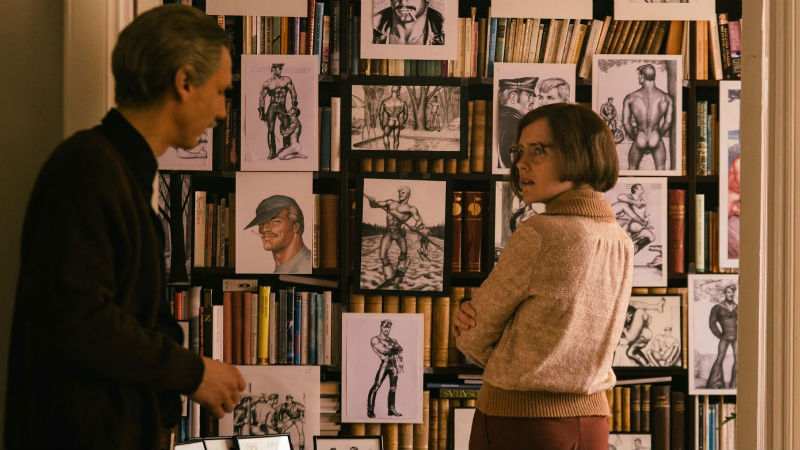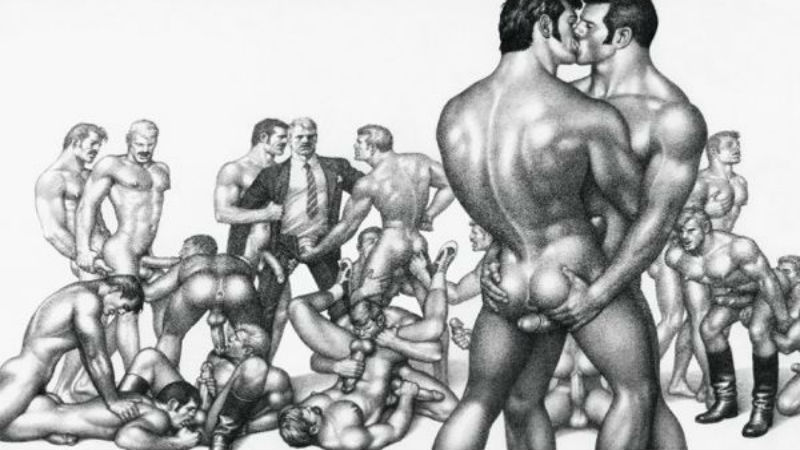Perhaps no other 20th century artist has captured the essence and the soul of male homosexuality as accurately and vibrantly as Touko Valio Laaksonen, best known as Tom of Finland outside his eponymous Scandinavian birth nation. Tom’s drawings of muscular men with bloated muscles and exaggerated phalli have featured in gay clubs, magazines and – most importantly – the imagination of gay men all around the planet at least since at least the 1980s. His immediately recognisable drawings continue to influence artists and to titillate libidos decades after artist’s death.
Tom of Finland is a very standard and effective biopic, portraying Tom from his youth at the aftermath of WW2 up until his death to emphysema in 1991. The five decades or so of his life are convincingly delivered by the Finnish actor Pekka Strang, who is both subtle and dramatic in his performance. Tom’s stoical attitude towards war, his insecurities in the face of homophobic scrutiny and a very Scandinavian sense of self-deprecating perfectionism are all there, composing a very complex and multilayered individual. This is no uni-dimensional character.

Overall, this is a very good movie, which provide moviegoers with both historical context and emotional insight into the life of a deeply subversive and provocative artist. It’s also a universal film that everyone – not just gay men – will find relatable. Tom’s work has drawn both admiration and disdain from different quarters of the artistic community, and the discussion whether his drawings are art or pornography will never cease. His influence, on the other hand, is not questionable.
The also Finnish filmmaker DomeKarukoski allow viewers to witness soldiers in Finland of the 1940s, the hedonistic underground of Berlin in the 1950s, plus the vibrant and colourful gay scene of California in the 1970s, and finally the Aids crisis of the 1980s. His ill-fated and tragic romance to a Finnish man called Veli (Lauri Tilkanen) is also a central topic, as and his affectionate yet somewhat distant relationship to his sister Kaija (Jessica Grabowsky). The movie also interestingly raises questions and notes some parallels between religion and gay culture: both are often insular and ritualistic. The photography is very convincing, even if at times a plush streak makes it more reminiscent of Pierre et Gilles than of Tom of Finland.
Karukoski deserves praise for making the film in Finnish (bar the bits in Germany and the US, where the respective local languages are predictably spoken), instead of opting for English in the name of commercial interests. He could have probably cast some international name such William Dafoe to play Tom of Finland, just like Abel Ferrara did three years ago in Pasolini. I am not a very big fan of films of movies that shun the local language in favour of profitability.

There is just one hardy and big problem with Tom of Finland, which wouldn’t be an issue for most films. Unlike many of Tom’s drawings, the movie Tom of Finland features no real sex and not even an erection. There’s what looks like a prosthetic penis being doused in a glass of beer, and a few naked Finns bathing naked in a river in the beginning of the movie, but otherwise this a very sexless endeavour. We doubt that anyone will ejaculate on the cinema seats or on the person next to them. How rude! This is of course a very significant flaw, as Tom’s work was teeming with explicit sexual activity (as you can see from the image above). It’s more of less the equivalent to making a film about Edith Piaf without music. Still, more than a worth a visit to the cinema!
Tom of Finland is out in cinemas across the UK in August, 2017. It’s now available on all major VoD platforms.








